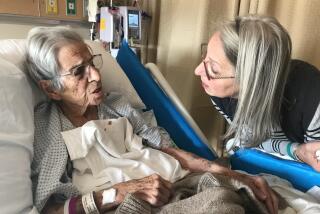Ex-Official Details Trauma in Year at Small Hospital : Medicine: Susan Garrett tells of grappling with soaring costs, rapid changes in technology and increased regulations. Her new book, ‘Taking Care of Our Own,’ delves into the system’s inner workings.
- Share via
YORK, Me. — A decade before health care reform emerged as a hot political issue, Susan Garrett became all too familiar with the pressures that fuel today’s demands to overhaul the system.
As administrator of York Hospital, a 79-bed community hospital in southern Maine, Garrett grappled with soaring costs, rapid changes in technology and increased government regulation that threatened to overwhelm the 80-year-old institution.
Her new book, “Taking Care of Our Own,” recounts the inner workings of York Hospital and the experiences of both the people who worked there and those who depended on the hospital for care.
It also concludes that small hospitals--York and the 2,400 others like it across the country--can provide important services that large, impersonal medical centers cannot match.
Garrett, who spent six years at York Hospital before leaving in 1983, compresses her story into a one-year period in which hospital officials reflected upon an uncertain future and decided to undertake a risky expansion program.
Now, as many small hospitals struggle for survival, York Hospital has done well, Garrett said. Amid competition from half a dozen hospitals between Portland and Portsmouth, N.H., it offers quality programs that meet the needs of the community.
Woven into her narrative are patients that range from Tim Bailey, the homeless man who shows up at the emergency room in bad weather or on Christmas, to Carrie Williams, the 85-year-old spinster who has to sell her heirlooms to pay for heart medication.
As administrator, it was Garrett’s task to find ways to accommodate the needs of townspeople like Bailey and Williams in a system with limited finances and strict rules regarding government reimbursement.
In human terms, she spells out the intricacies of shifting costs from Medicare patients to the self-insured and the financial risks of keeping patients in the hospital beyond the number of days calculated for each of the government’s 477 diagnosis-related groups.
Other challenges included calming the frayed nerves of impatient patients during a tumultuous summer evening in a crowded emergency room and mediating disputes among hospital staff members.
In one memorable incident, a nurse supervisor quit on the spot after a star surgeon flew into a rage because two instruments had not been set out in the operating room.
Writing as an insider forced Garrett to alter the facts, both by creating composites of real people and by compressing events into a shorter time frame.
“If I were a journalist, I would have done it differently,” she acknowledges. But by putting herself as narrator, she felt she was able to approach the subject in a way that gets at the truth more sharply than she might otherwise have done.
A community hospital, she said, offers “a natural continuum” ranging from doctors’ offices to acute care to home-based care. There are education programs, volunteer help for the elderly and respite for family care givers, all provided close to home.
“You can’t do all these things without a local hospital. I’m convinced of it. A distant hospital isn’t going to do it,” she said.
Garrett predicts that many small hospitals will move away from acute care in the coming years, making them more akin to health centers that place greater emphasis on outpatient services and public health.
Garrett, who now lives in Charlottesville, Va., but returns to her riverfront home in York for a few weeks in the summer, takes a more journalistic approach in a book she is writing about programs to help the elderly poor in isolated mountain hollows of rural Virginia.
“This is really a book about nurses, who are, I think, the future. They hold the system together. No question,” she said.






